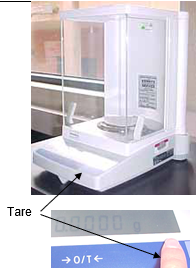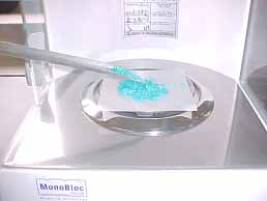2: Analytical Balances
- Page ID
- 361501
Analytical balances are used to measure the mass of a substance. The instructions describe the use of the balances in the Science Lab Building rooms 270 & 280. Always record your data to the precision of your instrument. If you are told to weigh 2 grams and the precision of your instrument is 100 \(\mu\)g, report it as 2.0000g.
The analytical balance measures the mass of substances to within 0.0001 g
Never pour chemicals on the balance, always use a weighing boat or weighing paper.
Step 1

Figure \(\PageIndex{1}\): Step 1
- The balance must be dry and contain no extraneous materials that may affect the accuracy of the measurement.
- Place the weighing paper onto the balance pan and close the side doors. To make sure the weight is stable, wait for the mass to stop changing or for a green triangle to appear.
- Press the “tare” button to recalibrate the balance to read 0.0000g. This prevents the mass of the weighing container from being included in the measurement
Step 2

Figure \(\PageIndex{2}\): Step 2
-Open the door and use a spatula to add the substance up to the desired mass. NEVER PLACE CHEMICALS ON THE BALANCE PAN
-Once again, close the door and then record the mass once the scale has stabilized.
Step 3

Figure \(\PageIndex{3}\): Step 3
-After finishing the measurements, brush the area around the balance pan to clean it of any remaining substance particles or spills.
-Properly discard the weighing paper.
-Keep the balance room clean!


